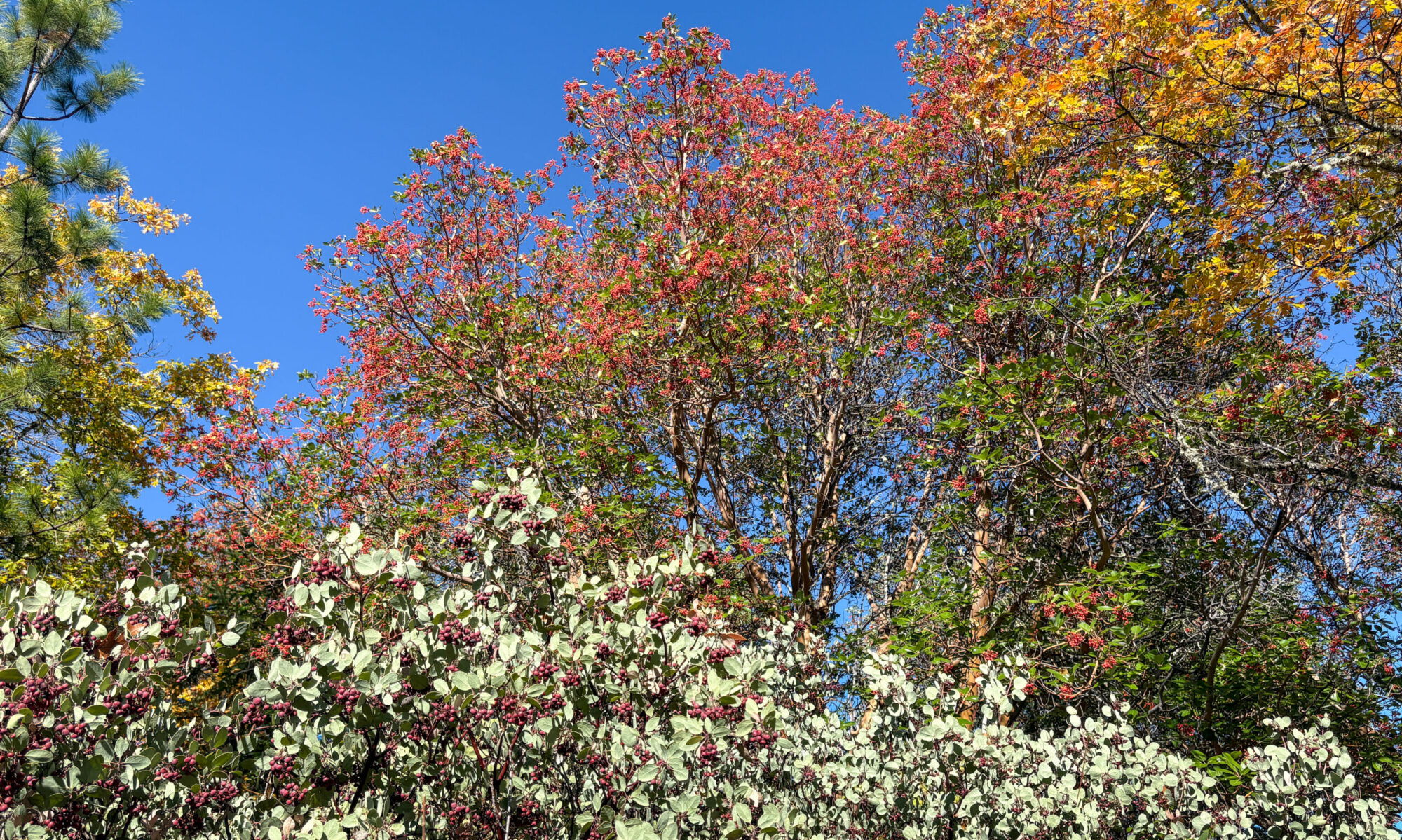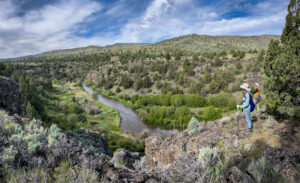
The days following our return from Ecuador were filled mostly with yard work in anticipation of spring planting. We’ve accepted the reality that ½ acre of landscaped property is a ponderous responsibility. Fortunately, much of the work preparing for summer is spent in the glory of springtime, and time outdoors is bliss. Even more so when the excitement of a road trip to Eastern Oregon is in the mix; our plan was to beat the mosquitos and visit the Malheur National Wildlife Area and Summer Lake in the spring.
Added to the excitement of that Spring Fling was a golf event at the Crooked River Golf Club. I’ve participated in a Cinco de Mayo celebratory birthday/golf event for years, and a reunion was held in Central Oregon. This allowed me three days with golfing friends before switching hats for a birding event with Sooney and our traveling companion, John Barker. Better yet, when I joined the group, dear friends Terry and Marty had remained in Page Springs for a welcome/farewell evening beneath our site’s lovely cottonwood tree.
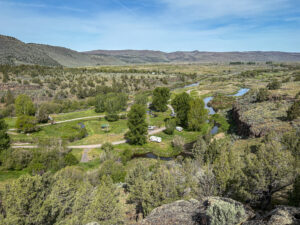
The following morning, the Karlins headed out and we chose to hike within the confines of the Page Springs CG. Not far from our site (#29) is the beginning of the Wilderness Trail that rises to a rocky plateau with views of the Donner und Blitzen Wild and Scenic River, the Malheur National Wildlife Refuge, the Steens Mountain high country, and the town of Frenchglen. The 1-mile trail meanders along the edge of the canyon and connects with a seasonal stream that drops back into the campground. Along our journey were some ancient Juniper trees sheltering beds of forest lichen beneath their canopy.
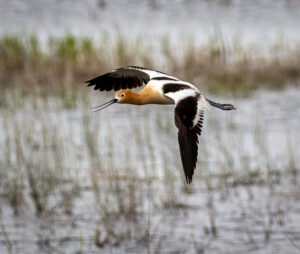
Page Springs Campground is located at the southernmost edge of the Malheur National Wildlife Refuge. Sooney and the Karlins had explored many of the birding hotspots prior to my arrival, so in the afternoons following our morning hikes we car-birded some new destinations and revisited some favorites. A considerable snowpack in the nearby Steens Mountains produced significant high water in areas we’d formerly birded as dry. After following a guide’s directions about where to see a Burrowing Owl, we headed south along the Central Canal route and, just south of the Field Station, birded a refilled Wright’s pond (a dry basin in several previous visits). This time water was abundant, and the soil rich. We walked along the canal road and, buoyed by a steady breeze, ibises, avocets, and stilts cavorted in the wind. They’d periodically drop down and dine on nutrients necessary for their eminent breeding.
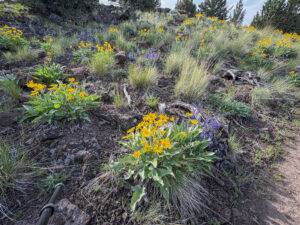
Another morning hike followed the Blitzen River upstream. The trail parallels the fast-flowing river for approximately 4 miles to the confluence with Fish Creek. The abundant snow fall (and resulting melt) had increased the water levels considerably; it also silted the water rendering this popular trout stream un-fishable until it clears a bit. We’ve never completed the entire trail, and due to some high water, our route detoured a ½ mile in and split to the left up and over the bluff. From up on top, the view was glorious and inspired an epic panoramic photo capturing much of the ancient valley. Adjacent to the trail, clusters of lupine, Deer Weed, Spreading Phlox, Arrowleaf Balsomroot, and Pungent Desert Parsley carpeted the hillside.
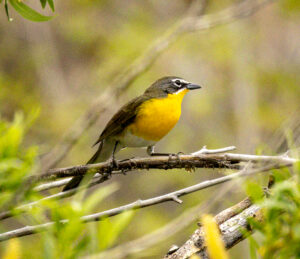
As we descended back into the river’s riparian area we heard the unmistakable call of the Yellow-breasted Chat and moments later we spotted a group of birders enjoying the antics of a couple testosterone-driven males. We speculated they were participating in pre-breeding behavior; the birds were chasing each other around—and through—a stand of willows, occasionally perching not far from each other and seemingly competing in a vocalization contest. Both sang a wild variety of phrases, and at one point Sooney captured over 4 minutes of the conversation. In order to generate volume, their throats would balloon with air and the Robin-sized birds would release a stream of calls. We spent the better part of a ½ hour enjoying this entertaining behavior; Chats are easy to hear and often difficult to see. These males were not in the least bit shy, and this sighting proved to be one of the highlights of this visit. Here’s a windy recording of one “chat” between the two birds:

We’ve monitored the arrival of feathery migrants to this important birding destination several times; just last year Sooney and her sister, Carol, covered much of the same territory as we did but in mid-April. It was considerably colder then and they kept their puffies on most days. Notably missing on this visit are the volumes of species observed in previous trips. Following a meal out at the Frenchglen Hotel, we slowly birded the mile or so constituting “Bobolink Alley” just north of the P Ranch. No Bobolinks yet—we did spot a single Sandhill Crane and a tower-full of roosting Turkey Vultures that was new to me. Oh, yea, and the ubiquitous Red-wing Blackbirds. Shortly after turning back into the campground property, we had another new sighting—a fledged Killdeer. Cute as can be; mostly legs supporting a feathery ball with a predominant bill.

The camp host was walking his dog, so we stopped for a chat. He’s been monitoring wildlife populations for years and has been really surprised at the lack of songbirds that, in previous years, would have filled the campground by now (May 11). He speculated that the avian flu has been responsible for some of the loss. He also mentioned there’s talk about a bad batch of grain seed that may have been contaminated with e-coli. Aside from numerous Yellows and butter-butts, a single orange-crowned, and hearing a couple Black-throated Gray warblers, generally fewer birds were in town. The good news is we beat the mosquitos. Also, wonderfully warm days encouraged restful visits in the shadow of our site’s cottonwood tree, accompanied by a Canyon Wren’s cascading cry emanating from its hideaway in the illuminated canyon wall.
Here’s a link to a gallery of photos captured during this trip. I think viewers will get a fair illustration of the beauty of Eastern Oregon. This link may be easier to view in older technology.
